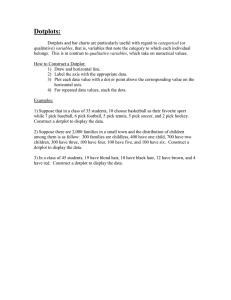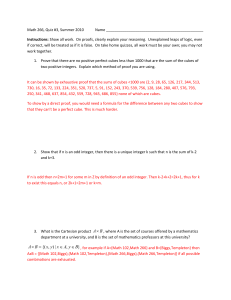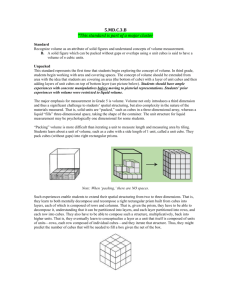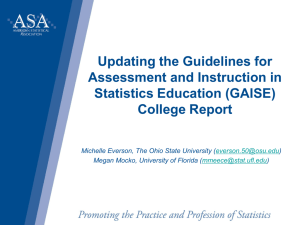How Long are the Names in my Class?
advertisement
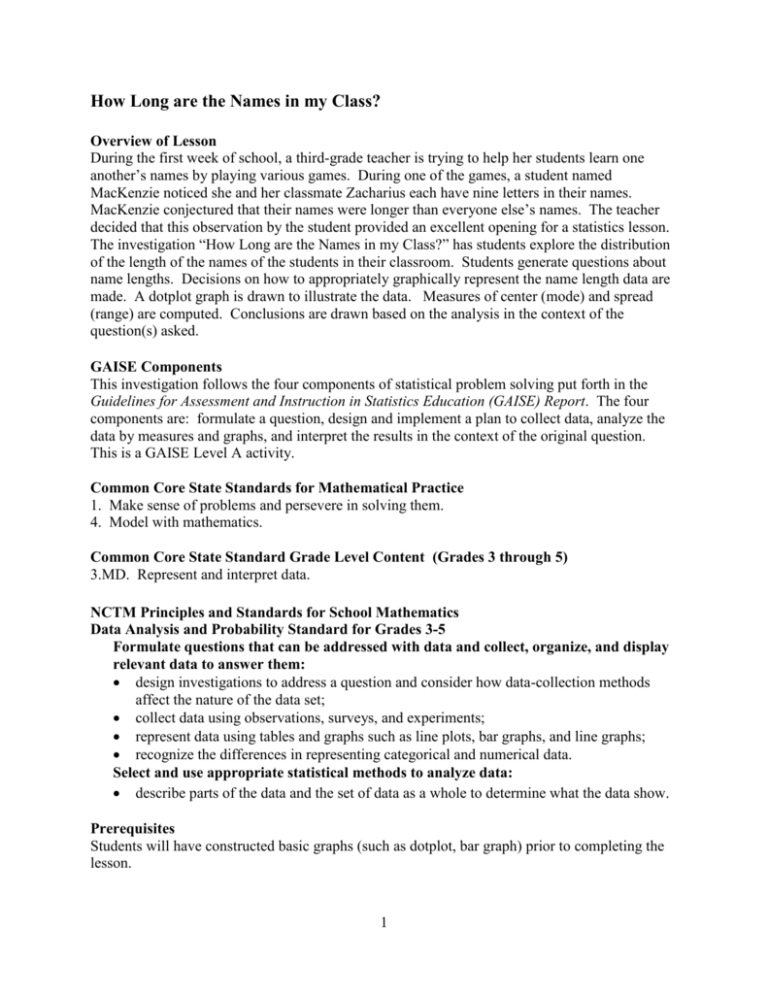
How Long are the Names in my Class? Overview of Lesson During the first week of school, a third-grade teacher is trying to help her students learn one another’s names by playing various games. During one of the games, a student named MacKenzie noticed she and her classmate Zacharius each have nine letters in their names. MacKenzie conjectured that their names were longer than everyone else’s names. The teacher decided that this observation by the student provided an excellent opening for a statistics lesson. The investigation “How Long are the Names in my Class?” has students explore the distribution of the length of the names of the students in their classroom. Students generate questions about name lengths. Decisions on how to appropriately graphically represent the name length data are made. A dotplot graph is drawn to illustrate the data. Measures of center (mode) and spread (range) are computed. Conclusions are drawn based on the analysis in the context of the question(s) asked. GAISE Components This investigation follows the four components of statistical problem solving put forth in the Guidelines for Assessment and Instruction in Statistics Education (GAISE) Report. The four components are: formulate a question, design and implement a plan to collect data, analyze the data by measures and graphs, and interpret the results in the context of the original question. This is a GAISE Level A activity. Common Core State Standards for Mathematical Practice 1. Make sense of problems and persevere in solving them. 4. Model with mathematics. Common Core State Standard Grade Level Content (Grades 3 through 5) 3.MD. Represent and interpret data. NCTM Principles and Standards for School Mathematics Data Analysis and Probability Standard for Grades 3-5 Formulate questions that can be addressed with data and collect, organize, and display relevant data to answer them: design investigations to address a question and consider how data-collection methods affect the nature of the data set; collect data using observations, surveys, and experiments; represent data using tables and graphs such as line plots, bar graphs, and line graphs; recognize the differences in representing categorical and numerical data. Select and use appropriate statistical methods to analyze data: describe parts of the data and the set of data as a whole to determine what the data show. Prerequisites Students will have constructed basic graphs (such as dotplot, bar graph) prior to completing the lesson. 1 Learning Targets Students will be able to graphically display data and interpret data. Time Required Part of 1 class period. Materials Required Sticky notes; pencil and paper. Instructional Lesson Plan The GAISE Statistical Problem-Solving Procedure I. Formulate Question(s) The teacher begins the investigation by asking students to think about the fact that name lengths in their classroom will vary. The teacher asks students to write some questions that they would be interested in investigating about the length of their classmates’ names. The class generates a list of questions, which the teacher records on the board. Some possible questions might be: 1. Who has the longest name? The shortest? 2. Are there more nine-letter names or six-letter names? How many more? 3. What’s the most common name length? 4. How many letters are in all of our names? 5. If you put all of the eight and nine-letter names together, will there be as many as the fiveletter names? II. Design and Implement a Plan to Collect the Data The teacher asks students to write their names on sticky notes and post them on the white board at the front of the room. Note that this is a census of the classroom because data is gathered from all students in the class. The students are given no direction about how to organize the sticky notes, so the students arbitrarily place them on the board. Example class data: 3, 3, 3, 4, 4, 5, 5, 5, 5, 5, 6, 6, 6, 6, 6, 6, 6, 6, 7, 7, 8, 9, 9, 9, 9 III. Analyze the Data In order to help students think about how to use graphical tools to analyze data, the teacher asks the students if they are easily able to answer any of the posed questions now by looking at the sticky notes, and the students say they cannot. The teacher then suggests that they think of ways to better organize the sticky notes. A student suggests grouping the names according to how many letters are in each name and constructing a frequency table. 2 Length 3 4 5 6 7 8 9 Tally ||| || ||||| |||||||| || | |||| Frequency 3 2 5 8 2 1 4 The teacher again asks if they can easily answer the questions that are posed. The students say they can answer some of the questions, but not easily. The teacher asks what they can do to make it easier to answer the questions. Because the students have been constructing graphs since kindergarten, they readily answer, “Make a graph.” The teacher then facilitates a discussion of what kind of graph they will make, and the class decides on a dotplot, given the fact that their names are already on sticky notes and given the available space on the board. Note that this display is not a bar graph because bar graphs are made when the data represent a categorical variable (such as favorite color). A dotplot is appropriate for a numerical variable, such as the number of letters in a name. The teacher then uses computer software to translate this information into a more abstract dotplot, as shown below. x x x x x 3 4 x x x x x x x x x x x x x x x x x x x x 5 6 7 8 Length of Name 9 Examining the dotplot helps the students focus on the general shape of the data, rather than on the particular names of the students. IV. Interpret the Results The teacher then facilitates a discussion of each question posed by the students, using the data displayed in the graph to answer the questions. Students also add appropriate labels and titles to the graph. The teacher helps students use the word “mode” to answer the question about the most common name length. She introduces the term “range” to help students answer the questions about shortest and longest names. Students visualize from the dotplot that there is variability in name length from individual to individual. The range gives a sense of the amount of variability in name length within the class. Using the range, we know that if the names for any two students are compared, the name lengths cannot differ by more than the value for the range. 3 The teacher then tells the students that there is another useful question they can answer from this data. Sometimes it is helpful to know “about how long most names are.” For instance, if you were making place cards for a class lunch party, you might want to know how long the typical name is in order to decide which size of place cards to buy. The typical or average name length is called the mean. Another way to think of this is, “If all of our names were the same length, how long would they be?” To illustrate this new idea, the teacher has students work in groups of four, and each child takes a number of snap cubes equal to the number of letters in his/her name. Then all four children at one table put all of their snap cubes in a pile in the middle of the table. They count how many cubes they have in total. Then they share the cubes fairly, with each child taking one at a time until they are all gone or there are not enough left to share. They record how many cubes each child received. (Students at some tables are able to use fractions to show that, for example, when there are two cubes left, each person could get half a cube. At other tables, the students simply leave the remaining two cubes undistributed.) The teacher then helps the students symbolize what they have done by using addition to reflect putting all the cubes in the middle of the table and using division to reflect sharing the cubes fairly among everyone at the table. They attach the words “mean” and “average” to this idea. Assessment Elizabeth, a 3rd grader collected the lengths of the names of all of the students in her class. The data collected by Elizabeth is shown in the following frequency table. Name Length 3 4 5 6 7 8 9 10 Frequency 3 2 4 8 4 2 4 1 (a) Draw a dotplot of the class name data and describe the data distribution. (b) Find the range in the length of class names. (c) Find the modal class name length. (d) Answer the question: A typical student in Elizabeth’s class has a name that is ________ letters long. Answer: (a) x x x x x 3 4 x x x x x x x x x x x x x x x x x x 5 6 7 8 Length of Name 4 x x x x x 9 10 The shortest name has 3 letters. The longest name has 10 letters. Most of the names have between 5 and 7 letters. (b) The range is 10 – 3 = 7 letters. (c) The mode is 6 letters. (d) A typical student in Elizabeth’s class has a name that is 6 letters long. Possible Extensions (to GAISE Level B) 1. After the dotplot is constructed, the teacher can ask students to describe the shape, center and spread of the data distribution and to examine the distribution for clusters, gaps, and potential outliers. 2. The teacher can ask students to construct a boxplot to display the data distribution and to determine if there are any outliers using the 1.5xIQR rule. 3. The teacher can ask students to calculate and discuss measures of center (mean, median). 4. The teacher can ask students to discuss the spread of the name length distribution (range, interquartile range, mean absolute deviation). 5. The teacher can ask students to compare the lengths of names for their class to the lengths of names for another class. References 1. This lesson is based on an investigation appearing in Guidelines for Assessment and Instruction in Statistics Education (GAISE) Report, ASA, Franklin et al., ASA, 2007 http://www.amstat.org/education/gaise/ . 2. This lesson is based on the Investigation: How Long are our Shoes? In Bridging the Gap Between the Common Core State Standards and Teaching Statistics (2012, in press). Authors: Pat Hopfensperger, Tim Jacobbe, Deborah Lurie, and Jerry Moreno. 5 How Long are the Names in My Class? Activity Sheet 1. Some questions about the lengths of names of students in our class: 2. Write your name on a sticky note and post the note on the white board at the front of the room. 3. Complete the following table for the class name length data: Name Length 3 Tally Frequency 4 5 6 7 4. Construct a dotplot of the class name length data. 3 4 5 6 7 8 9 5. What is the most common name length? 6. What is the range in name lengths? 7. About how long are most names in the class? 6 8 9
